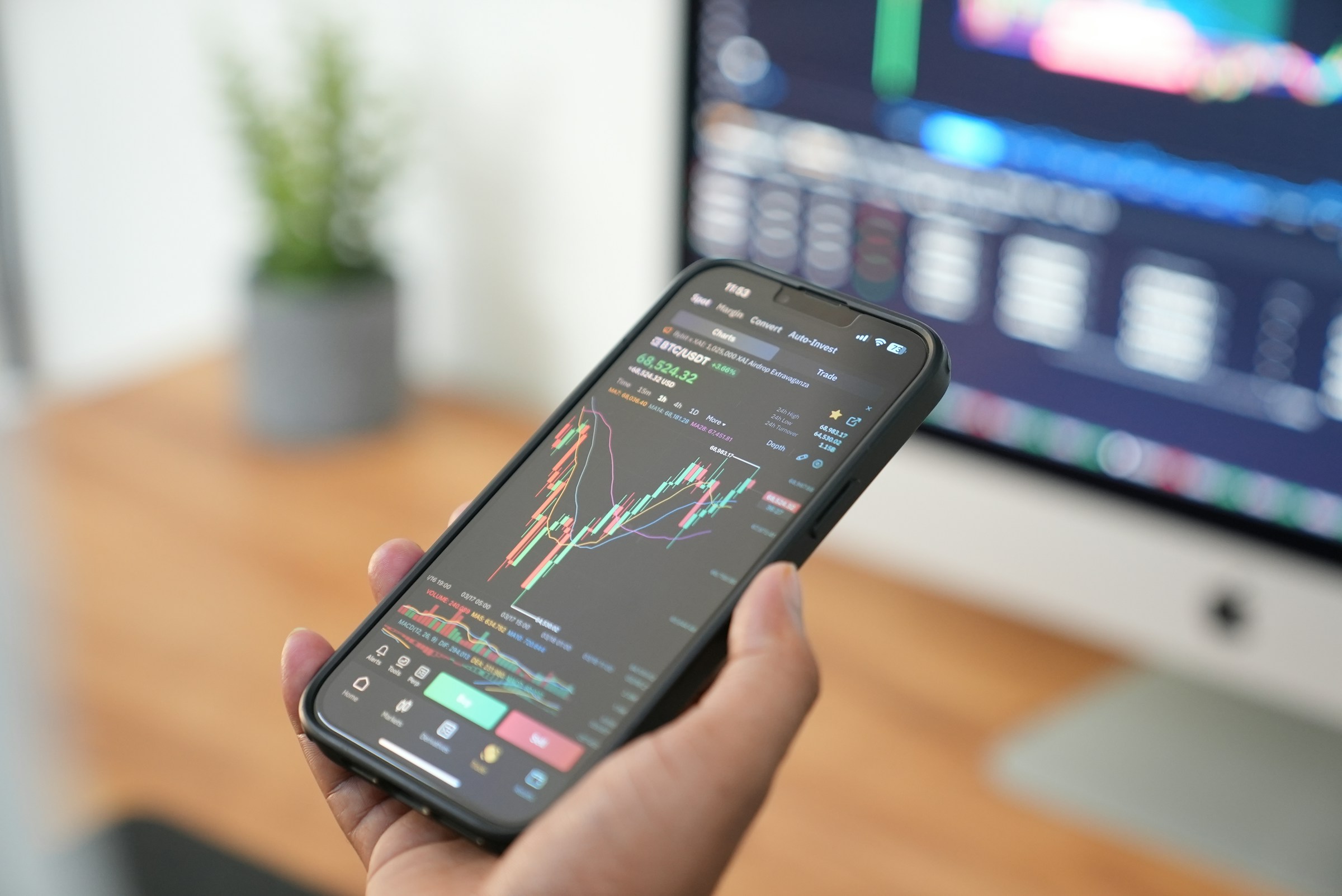Is Day Trading Profitable + 20 Tips for Day Trading
Wondering is day trading profitable? Discover realistic answers and 20 actionable tips to improve your chances of success.

Day trading is like riding a roller coaster, exciting but risky. Unlike a thrill ride, however, losing money is a very real possibility. So, is day trading worth it? Many traders burn out and give up without ever knowing the answer. This guide will help you understand, smart money trading, how to trade safely and profitably using clever money trading techniques. This guide will help you maximize your trading potential and capital more effectively.
Aqua Funded’s funded trading program can help you make money day trading. It offers a free step-by-step program that has helped thousands of traders learn how to trade profitably.
Benefits of Day Trading

Why Day Trading Can Offer Big Gains
Day trading has the potential for substantial profits. With the right skills and strategies, traders can leverage trades to capitalize on even small price changes, turning them into significant gains. Being able to predict market trends and act quickly can lead to impressive financial rewards.
Trading on Your Terms
One of the biggest draws of day trading is the independence it offers. You get to call the shots, setting your hours and strategies. This freedom is a significant advantage for those seeking to escape the traditional nine-to-five routine.
Quick Thinking Pays Off
Day trading is all about making rapid decisions. You need to analyze market conditions and execute trades quickly. This fast-paced environment can be stimulating and rewarding, especially if you thrive under pressure.
Keep Your Losses in Check
Since day traders close all positions by the end of the trading day, there's no risk of overnight market changes affecting your trades. This can help limit potential losses, giving you more control over your investments.
Easy In, Easy Out
Day trading in highly liquid markets means you can easily buy and sell assets. Plus, thanks to technology and online trading platforms, day trading is more accessible than ever.
Learn Fast or Go Home
With day trading, you get immediate feedback on your strategies and decisions. This real-time evaluation enables you to learn from mistakes quickly and refine your approach, thereby accelerating your development as a trader.
Is Day Trading Profitable

The Reality: Most Day Traders Lose Money
Many day traders experience losses more often than gains. Research from the University of California found that only 13% of day traders recorded profits over a six-month period. Another study noted that just 1% of traders consistently beat the market once trading costs are factored in. So, while making a profit is possible, it's rare and requires skill, discipline, and a strong strategy.
Day Trading Returns: Unrealistic Expectations
Some traders enter the market with the hope of achieving double-digit monthly returns. In reality, professional traders at institutions typically aim for annual returns of 10-15%, rather than monthly returns. For individual traders, even achieving consistent 1% daily profits is tough. This would theoretically lead to over 250% annual returns, which is nearly impossible due to costs, taxes, and stress.
Impact of Trading Costs
Transaction costs, including commissions, spreads, and slippage, can significantly impact your returns. Trading actively every day increases your exposure to fees and losses from bad fills. Even skilled traders who are adept at timing the market might still end up unprofitable due to these expenses.
Profitability Increases with Experience—but Only Slightly
A Taiwanese study found that only 5% of traders generated profits over 15 years. Among frequent traders, only the top 1% consistently achieved profitability. More experienced traders had slightly better outcomes, but not by much, suggesting that merely spending time in the market won’t guarantee success.
Institutional vs Retail Traders
Institutional traders have access to superior technology, faster execution, and substantial capital, giving them a significant edge. Retail traders, lacking these resources, are often at a disadvantage. So, the average retail trader’s chances of long-term profitability are low.
Psychological & Emotional Challenges
Even with a good strategy, psychological factors such as overtrading, revenge trading, and fear can erode your edge. Day trading is extremely stressful, and emotional decision-making often leads to losses. Trading requires not just skill and strategy, but also emotional discipline.
Survivorship Bias
You often hear success stories from traders who make a lot of money, but you don’t hear about the countless others who failed and quit. This creates a false perception that trading is more profitable than it really is.
Turn your trading skills into substantial profits without risking your capital. Our funded trading program offers access to accounts of up to $400,000, featuring the most flexible trading conditions in the industry, including no time limits, easy-to-achieve profit targets, and a potential profit split of up to 100%. Join over 42,000 traders worldwide who’ve already collected more than $2.9 million in rewards, all backed by our 48-hour payment guarantee. Start trading today with instant funding options or prove your skills through our customizable challenge paths and keep up to 100% of what you earn.
Related Reading
- How Much Money Do You Need to Start Trading
- How Long Does It Take to Learn Trading
- What Challenges Do Traders Face?
- Futures vs Stocks Trading
- Why is Trading So Hard
- How to Swing Trade
- How to Multiply Your Money
- How to Start Trading With No Money
20 Tips for Making Money With Day Trading

1. Aqua Funded: Trade Big Without Risking Big
Turn your skills into real profits without risking your capital. AquaFunded offers access to accounts of up to $ 400,000 with the most flexible trading conditions in the industry. No time limits, easy target reach, and up to 100% profit split. Over 42,000 traders have collected more than $2.9 million in rewards, all of which are backed by a 48-hour payment guarantee. Start trading today with instant funding or prove your skills through customizable challenges and keep up to 100% of what you earn.
2. Start Small and Build Up
Don’t jump into large trades right away. Start with small positions to avoid early financial mistakes. Trading with small amounts helps you learn market behavior, build discipline, and gain confidence. Once you consistently see positive results, gradually increase your position sizes while maintaining risk control.
3. Set Stop-Loss and Take-Profit Orders
Stop-loss orders limit your downside by automatically closing a trade at a set loss level. Take-profit orders secure profits before the market reverses. Day traders face fast-moving markets where hesitation can result in significant losses. These orders enforce discipline and protect you from emotional errors like holding onto losing trades or exiting winners too soon.
4. Practice with Paper Trading
Paper trading involves using a simulated account to execute trades in real-time without risking money. This is crucial for understanding order execution, strategy implementation, and navigating the platform. It builds experience and confidence without financial consequences. Most brokers offer demo accounts for this purpose.
5. Focus on Liquid and Volatile Stocks
Liquidity ensures that there are enough buyers and sellers, allowing you to enter and exit positions quickly without significant price slippage. Volatility increases the potential for intraday price movement, creating profit opportunities. Look for stocks with high average daily trading volume and significant daily price ranges. Avoid illiquid or low-volume stocks that can trap you.
6. Pre-Market Scanning and Preparation
Successful traders prepare in advance of the market opening. Use pre-market screeners to identify stocks that meet your criteria, such as those that gap up/down, exhibit unusual volume, or feature breaking news. Mark key support and resistance levels on your charts, define your watchlist, and prepare your strategy in advance. Being ready before the bell increases your confidence and execution speed.
7. Use Technical Indicators Wisely
Indicators like moving averages, RSI, Bollinger Bands, MACD, and volume help identify entry and exit points. For example, RSI can tell you if a stock is overbought or oversold, while moving averages can signal trend direction. However, don’t rely solely on indicators; use them with price action, volume, and market context to make informed decisions.
8. Understand Level II and Order Flow
Level II market data shows real-time bid and ask prices along with market depth. It gives insight into the strength of buyers vs. sellers at each price level. Combined with time and sales data, it helps you understand momentum and predict short-term movements. Mastering this can give you an edge, especially in scalping strategies.
9. Trade During Optimal Times
The first and last hours of the trading session typically have the highest volatility and volume, offering the best opportunities for day trading. Midday trading is often slow and choppy. For beginners, it's best to trade during these peak times when patterns are more reliable and spreads are tighter. Avoid trading during low-volume periods unless you have a specific edge.
10. Eliminate Distractions
Day trading requires full concentration. Avoid distractions like social media, texting, or multitasking. Set up a dedicated workspace with multiple screens, a fast internet connection, and your trading tools ready. Even a few seconds of distraction can mean missing a good trade or holding onto a bad one for too long. Discipline and focus are non-negotiable for consistent profits.
11. Keep Emotions in Check
Fear, greed, overconfidence, and frustration are emotional states that sabotage many traders. One emotional mistake can wipe out several winning trades. Train yourself to remain calm under pressure, follow your plan strictly, and accept losses as a natural part of the trading process. Emotional control separates a professional from an amateur.
12. Maintain a Trading Journal
Track every trade with details like entry/exit points, time, indicators used, size, profit/loss, and emotional state. Review your journal regularly to identify patterns in both winning and losing trades. This self-review process helps refine your strategy, correct mistakes, and gain a deeper understanding of your trading psychology. A detailed journal is one of the most powerful tools for improvement.
13. Stay Flexible and Adaptive
Markets are dynamic. A strategy that works in one condition may fail in another. Be prepared to adapt your approach, stop trading when setups aren’t present, and adjust your expectations accordingly. Rigidity can lead to forced trades and unnecessary losses. Learn to read the market’s mood each day.
14. Know the Regulatory Rules
If you’re in the U.S., you must maintain a $25,000 minimum balance to make more than four day trades in five days. Ignorance of these rules can result in account restrictions. Ensure you understand the regulations of your broker and the country in which you operate to avoid unnecessary penalties or account blockages.
15. Be Cautious with Leverage and Margin
Using borrowed money can amplify both gains and losses. Many traders go broke by overleveraging positions. Always calculate your risk before entering a trade, and know that leverage is a double-edged sword. Only use margin when your strategy is consistently profitable and you fully understand the risk.
16. Limit Trades and Watchlist
Avoid spreading yourself too thin by trading too many stocks at once. Stick to 1–3 stocks per day to monitor price action effectively and react quickly. Similarly, narrow your watchlist to stocks that match your strategy. This allows you to become more familiar with the behavior and patterns of specific stocks.
17. Avoid “Hot Tips” and Noise
Many new traders fall into the trap of following social media hype or chatroom tips. This leads to FOMO trades based on someone else's opinion rather than solid analysis and reasoning. Stick to your trading plan, conduct thorough research, and approach day trading as a business, not a game of chance.
18. Use Proper Position Sizing
Position sizing is crucial for effective risk management. Determine how much you’re willing to lose per trade, often 0.5–1% of your account, and size your position accordingly. This ensures that even a string of losses doesn’t significantly damage your capital. Risking too much on one trade is one of the fastest ways to blow up an account.
19. Conduct Daily Reviews
Set aside time after the market closes to analyze your performance. Did you follow your rules? Did you overtrade? Did emotions influence your actions? Reviewing your trading day helps catch bad habits early and reinforces good discipline. It also allows you to adjust your strategy in response to current market behavior.
20. Invest in Continuous Learning
The markets evolve constantly. Keep reading books, taking courses, watching expert traders, and analyzing your performance. Study trading psychology, technical patterns, and risk management. The most successful traders are lifelong learners who constantly improve their edge.
Related Reading
- What Happens if You Blow a Funded Account
- How to Become a Professional Trader
- Best Market to Trade for Beginners
- Tips for Day Trading
- Common Trading Mistakes
- Margin vs Leverage
- How Much Can You Make Day Trading With 100k
- Scalping Trading Strategy
- Margin vs Leverage
- Day Trading vs Options
- Best Time Frame for Day Trading
How Much Money Do You Need for Day Trading

The Legal Minimum for Day Trading: What You Need to Know
The Pattern Day Trader (PDT) rule requires maintaining a minimum account balance of $25,000 if you execute four or more day trades within five business days. This applies to margin accounts trading U.S. equities. If your balance drops below this threshold, your broker might freeze your account or restrict your trading. Simply put, to day trade U.S. stocks freely, you need at least $25,000.
Trading Without $25,000: Alternative Options
If you lack $25,000, you have some options to consider. Using a cash account allows you to trade without PDT restrictions, but you’ll need to wait for funds to settle before reusing them, making it suitable for low-frequency traders. Alternatively, consider exploring other markets, such as futures, forex, or cryptocurrency, which have lower entry points and no PDT rule.
Recommended Starting Capital: Practical Considerations
While $25,000 is the legal minimum for unrestricted stock day trading, practical starting capital recommendations vary. For stocks, aim for $30,000–$50,000 to handle drawdowns and fees. Options trading can begin with $5,000–$10,000, although it carries a high level of risk. Futures typically require an initial investment of $5,000–$10,000. For forex, $1,000–$3,000 is advised, despite lower broker minimums. Having extra capital helps you manage losses, commissions, and volatility more safely.
Why More Money is Often Better
Even if the minimum is $25,000 or less, additional capital offers several advantages. It enables better risk management, requires less leverage, provides more flexibility in position sizing, and alleviates psychological pressure. More capital can help you weather the ups and downs of the market with less stress.
Broker Requirements Vary: Here’s What to Consider
Please note that broker requirements may vary, with some brokers having higher minimums. Additionally, consider factors such as commissions, platform fees, margin requirements, and withdrawal restrictions when selecting a broker.
If you're looking to maximize your trading potential without risking your capital, check out AquaFunded’s funded trading program. With access to accounts up to $400K and the most flexible trading conditions in the industry, you can turn your skills into substantial profits. Join over 42,000 traders who’ve already collected more than $2.9 million in rewards.
Join Our Funded Trading Program Today - Trade with our Capital and Keep up to 100% of the Profits.
Day trading isn't just about rapid buying and selling. It's about seizing opportunities, understanding market volatility, and making informed decisions. For many, it’s a full-time pursuit that requires dedication and a keen eye for patterns. The allure of day trading lies in its potential for substantial returns, but it’s crucial to approach it with the right mindset and tools. Whether you’re engaging in swing trading or scalp trading, success hinges on your ability to adapt and manage risk effectively. AquaFunded enables this by offering access to large accounts, instantly or through customizable challenges, a game-changer for traders looking to scale without financial constraints.
Day Trading Without Risking Your Capital
Imagine trading without the fear of losing your own money. AquaFunded makes this a reality by providing access to accounts of up to $400,000. This means you can trade with confidence, knowing your funds are safe. This kind of setup allows traders to focus on strategies and execution rather than the stress of potential losses. It’s a win-win situation for anyone looking to succeed in day trading.
Maximize Your Profits with Flexible Conditions
AquaFunded understands that traders need flexibility to thrive. That’s why they offer the most trader-friendly conditions in the industry. No time limits mean you can take your time to achieve your goals. Easy-to-reach profit targets make it accessible for traders of all skill levels. With a profit split of up to 100%, you can keep what you earn. This flexibility allows traders to operate on their terms and maximize their profitability.
Join a Global Community of Successful Traders
With over 42,000 traders worldwide, AquaFunded is a testament to the power of collaboration and shared success. This community has already collected over $2.9 million in rewards, demonstrating that the model is effective. And with a 48-hour payment guarantee, you can trust that your efforts will be rewarded promptly. By joining AquaFunded, you become part of a global network of traders who are committed to success.
Start Trading Today with Instant Funding Options
No one likes waiting around for opportunities. With AquaFunded, you can start trading immediately, thanks to instant funding options. This means you can jump right into the action and begin working towards your financial goals. Alternatively, if you prefer a challenge, AquaFunded offers customizable paths to prove your skills and keep up to 100% of what you earn. This flexibility ensures that there’s an option for every trader, regardless of experience level.
Related Reading
- Why Do Most Day Traders Fail
- How to Take Profits in Trading
- Fair Value Gap Trading
- Best Time of Day to Trade Stocks
- How to Make Money Online Trading
- Prop Firms With No Time Limit
- Different Stock Trading Strategies
- Swing Trading Prop Firms
- Best Technical Indicators for Day Trading


